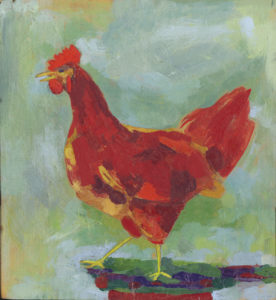The Sesquicentennial Chicken

The Rhode Island Red breed began in Little Compton, a seaward-turned village on the eastern shore of the Sakonnet River between Newport, Rhode Island and New Bedford, Massachusetts. Before the Red, chickens were minor players; they were allowed to run loose until it was time for a chicken dinner. Their eggs were gathered, but hens laid for just weeks, or at most a few months each year. But as the industrial revolution brought thousands of people to towns and cities, a demand arose for farm-fresh produce, including eggs and chicken meat. Farmers sold live chickens, too, and ships’ agents bought some of them to put aboard outward-bound whaleships and merchantmen.
Shipmasters bought replacements abroad, and one such bird, a Malay or a Chittagong rooster caught the eye of William Tripp, a Little Compton market man who set it loose with his other chickens. The cross-bred birds grew larger, provided more meat, and became productive layers. In 1854 Tripp and John Macomber began breeding “Tripp’s Yaller (yellow) Fowl” for those characteristics. Some time later, Isaac Champlin Wilbour bought some of Tripp’s birds, and soon his 200-acre spread in Little Compton was the largest poultry farm in America. By 1886 he could deliver 4,000 dozen eggs in a single week.
A decade later Wilbour began advertising his “Rhode Island Reds” in poultry journals, though Lester Tompkins, a breeder from Fall River, Massachusetts is generally credited for the bird’s dark mahogany color. In 1901 Wilbour’s commercial name was confirmed by the American Rhode Island Red Club, an organization established to standardize the breed. On its hundredth birthday in 1954, the Red was designated the State Bird of Rhode Island.
The remarkable productivity of the breed built the foundation for the modern poultry industry. Surprisingly, the Rhode Island Red is now on a watch-list of endangered “heritage” fowl. Intensive cross-breeding since 1940 has further increased production at the cost of large size and distinctive color: today there are fewer than 5,000 breeding registries worldwide for what was once the standard Rhode Island Red chicken.
